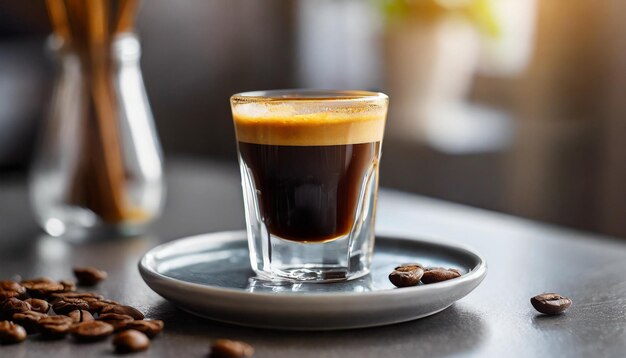Espresso, the foundation of many beloved coffee drinks like lattes, cappuccinos, and macchiatos, has a reputation for being tricky to master. Whether you’re a seasoned coffee enthusiast or a beginner, the allure of making the perfect espresso at home is undeniable. But can you brew it better than your local coffee shop? Let’s dive into the ultimate espresso challenge and explore what it takes to brew a cafe-quality espresso in your own kitchen.
What Makes a Perfect Espresso?
Before we jump into how to brew espresso at home, it’s essential to understand what makes a “perfect” espresso. Several factors contribute to the ideal shot:
- Crema: The rich, golden foam on top of an espresso shot, formed by the oils in the coffee beans, is a key indicator of a well-brewed espresso.
- Taste: A perfect espresso should have a balance of sweetness, acidity, and bitterness. It should be bold and full of flavor but not overwhelming.
- Temperature: The brewing temperature should ideally be around 190°F to 200°F (88°C to 93°C) for optimal extraction.
- Consistency: The shot should be pulled evenly, with a steady stream of espresso that forms a smooth, rich texture.
Now that we know what to look for, let’s explore whether you can match or even surpass the quality of your local barista at home.
Step 1: Invest in the Right Equipment
One of the most crucial steps in brewing a great espresso at home is having the right equipment. While a simple espresso machine may suffice for some, investing in higher-quality tools will make a significant difference.
- Espresso Machine: A good espresso machine allows you to control important variables like temperature and pressure. There are several types to choose from, ranging from manual machines to fully automatic ones. A semi-automatic machine strikes a balance between control and convenience.
- Coffee Grinder: Freshly ground coffee is essential for great espresso. Burr grinders are the best choice as they provide consistent grind size, which is critical for extraction. Blade grinders, on the other hand, produce uneven grinds that can result in an inconsistent shot.
- Coffee Beans: Quality beans are the heart of any great espresso. Opt for freshly roasted beans from reputable roasters, and be sure to grind them just before brewing.
- Tamper: A tamper is used to press the coffee grounds into the portafilter evenly, which ensures uniform extraction.
- Scale: A scale helps you measure your coffee precisely, ensuring the correct coffee-to-water ratio for the perfect shot.
- Water Quality: High-quality, filtered water is essential for good espresso. The water should be free of impurities and have the right mineral content to extract the flavors from the coffee beans.
Step 2: Get the Grind Right
The grind size is perhaps the most important factor in making espresso. For espresso, you’ll need a fine, consistent grind—think of the texture of table salt. If the grind is too coarse, the water will pass through too quickly, resulting in under-extraction (a weak, sour shot). If the grind is too fine, the water will struggle to pass through, leading to over-extraction (a bitter, unpleasant shot).
Experimenting with grind size is crucial, and it may take some trial and error. Always adjust the grind based on how the espresso is extracting: if your shot pulls too quickly, make the grind finer; if it drips too slowly, make the grind coarser.
Step 3: Perfect Your Brewing Technique
Brewing espresso involves several steps that require precision:
- Preheat Your Equipment: Before brewing, make sure your machine, portafilter, and cup are all preheated. This ensures your espresso maintains the right temperature during extraction.
- Weigh Your Coffee: A standard starting point is around 18-20 grams of coffee for a double shot of espresso. You can adjust this based on your taste preferences.
- Tamp Evenly: After adding the ground coffee to the portafilter, use your tamper to press the grounds down evenly and with consistent pressure. An uneven tamp can lead to channeling, where water flows unevenly through the coffee, affecting the shot’s quality.
- Brew Time: The ideal shot of espresso takes around 25-30 seconds to brew. If your shot is pulling too fast or too slow, adjust your grind size or tamping technique.
Step 4: Experiment with Flavor
While achieving the right technical aspects of espresso brewing is essential, the flavor profile is where you can really make your espresso stand out. Different beans offer a range of flavors, from fruity and bright to chocolatey and nutty. Additionally, adjusting variables such as the coffee-to-water ratio, brew time, and grind size allows you to experiment with different flavors.
To enhance the flavor of your espresso, you can also try experimenting with milk texture for drinks like lattes and cappuccinos. Achieving the perfect microfoam will help elevate the richness and creaminess of your drinks.
Step 5: Master the Art of Consistency
While brewing a great shot of espresso might come easily once you’ve perfected the process, maintaining consistency over time can be a challenge. Keep a journal of your measurements, grind sizes, and techniques to ensure that you can replicate successful shots. Fine-tuning your espresso skills requires attention to detail, patience, and practice.
Can You Brew It Better at Home?
With the right equipment, technique, and a little bit of trial and error, brewing espresso at home can rival, and sometimes even surpass, the quality of your local coffee shop. However, it takes dedication to fine-tune every variable involved in the brewing process.
If you’re just getting started, it might take a bit of time to reach your desired level of consistency. But once you get the hang of it, you’ll find that brewing espresso at home is both rewarding and cost-effective. Plus, there’s a certain satisfaction in enjoying a cup you’ve brewed yourself, knowing that you’ve mastered the art of espresso.
Whether you’re in it for the perfect espresso shot or ready to explore the world of lattes, cappuccinos, and more, the ultimate espresso challenge is all about the journey—and there’s no better time to start than now!








